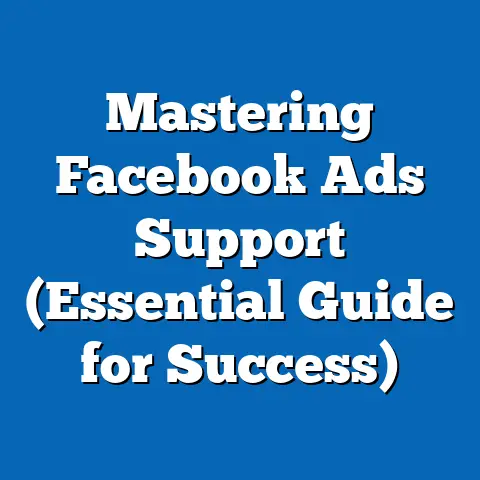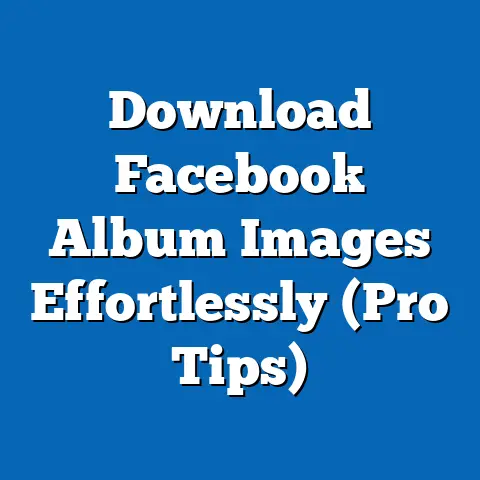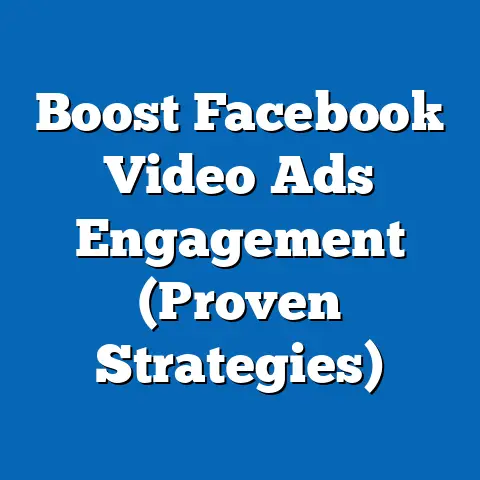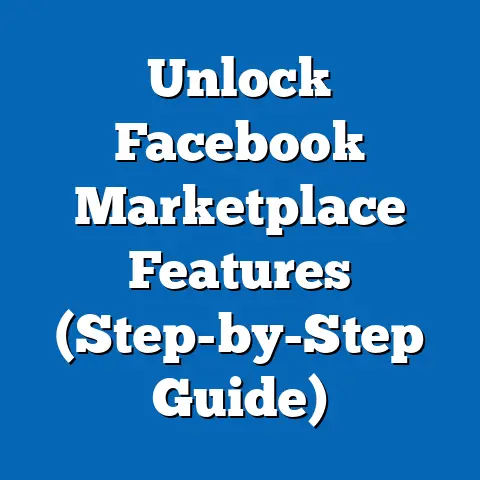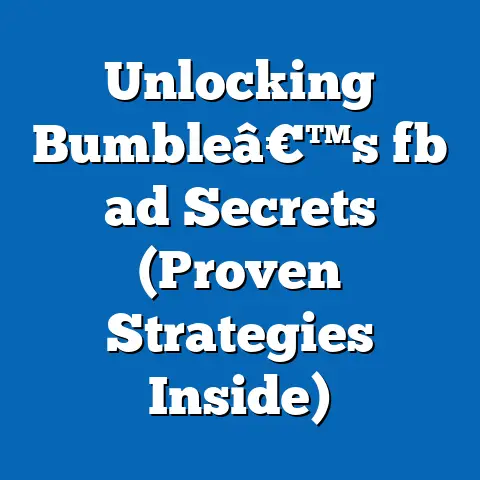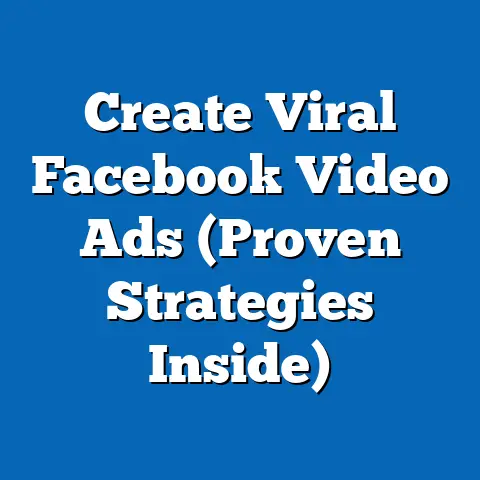Unlock the Best Facebook Ad Format (Proven Strategies)
Facebook. It’s been a constant in the digital landscape for what feels like forever. Remember when it was just a platform for connecting with college friends? Now, it’s a marketing powerhouse, and despite all the new platforms popping up, Facebook advertising remains incredibly durable and effective. I’ve been working with Facebook Ads since the very beginning, and I’ve seen it evolve from simple text ads to the dynamic, engaging formats we have today. One thing has remained constant: choosing the right ad format is crucial to maximizing your return on investment (ROI) and truly connecting with your target audience.
In this article, I’m going to walk you through everything you need to know to create successful Facebook ad campaigns. We’ll cover:
- A comprehensive overview of all the Facebook ad formats currently available, including their key features, benefits, and ideal use cases.
- The importance of understanding your audience and how to leverage Facebook’s powerful targeting tools to reach the right people with the right message.
- Proven strategies for each ad format, including best practices for imagery, copywriting, video creation, and more.
- How to measure the success of your ads and optimize them based on performance data.
My goal is to equip you with the knowledge and tools you need to create Facebook ad campaigns that drive real results for your business. So, let’s dive in!
Overview of Facebook Ad Formats
Facebook offers a diverse range of ad formats, each designed to cater to different marketing objectives and target audiences. Understanding these formats is the first step towards creating effective campaigns. Here’s a breakdown of the most popular options:
Image Ads
Image ads are the simplest and most straightforward ad format. They consist of a single image, accompanied by text and a call-to-action (CTA) button.
- Key Features: Easy to create, visually appealing, and versatile.
- Benefits: Great for brand awareness, driving traffic to your website, and promoting specific products or services.
- Ideal Use Cases: Announcing sales, showcasing products, or promoting blog posts.
I’ve seen image ads work wonders for local businesses promoting special offers or new menu items. The key is to use high-quality, eye-catching images that immediately grab attention.
Video Ads
Video ads are dynamic and engaging, allowing you to tell a story and connect with your audience on a deeper level.
- Key Features: Can be short or long-form, include audio and visual elements, and are highly customizable.
- Benefits: Excellent for brand storytelling, demonstrating product features, and driving engagement.
- Ideal Use Cases: Product demos, customer testimonials, behind-the-scenes glimpses, or brand stories.
I once worked with a tech startup that used video ads to explain their complex software in a simple and engaging way. The video ads significantly increased their website traffic and lead generation.
Carousel Ads
Carousel ads allow you to showcase multiple images or videos within a single ad unit. Each image or video has its own headline, description, and CTA button.
- Key Features: Versatile, interactive, and allows you to tell a more complete story.
- Benefits: Great for showcasing multiple products, highlighting different features, or telling a sequential story.
- Ideal Use Cases: E-commerce businesses showcasing their product catalog, travel agencies highlighting different destinations, or restaurants showcasing their menu items.
Carousel ads are my go-to for e-commerce clients. I’ve seen them significantly increase click-through rates (CTR) and conversions by allowing users to browse multiple products directly within the ad.
Slideshow Ads
Slideshow ads are similar to video ads, but they are created using a series of static images or videos. Facebook automatically animates the slideshow, creating a visually appealing experience.
- Key Features: Easy to create, cost-effective, and mobile-friendly.
- Benefits: Great for businesses with limited video resources, for conveying a message quickly, and for targeting mobile users.
- Ideal Use Cases: Promoting events, showcasing product features, or telling a short story.
Slideshow ads are a fantastic option for businesses on a budget. I’ve used them to create compelling ads for local events and promotions without the need for expensive video production.
Collection Ads
Collection ads are designed for e-commerce businesses, allowing you to showcase a catalog of products in a visually appealing and immersive way. They typically consist of a cover image or video, followed by a selection of related products.
- Key Features: Visually appealing, immersive, and optimized for mobile shopping.
- Benefits: Great for driving product discovery, increasing sales, and improving the mobile shopping experience.
- Ideal Use Cases: E-commerce businesses promoting their latest collections, seasonal sales, or specific product categories.
I’ve seen collection ads dramatically increase sales for e-commerce clients by creating a seamless and engaging shopping experience on mobile devices.
Instant Experience Ads
Instant Experience ads (formerly known as Canvas ads) are full-screen, mobile-optimized ads that load instantly when clicked. They allow you to create interactive and immersive experiences, such as product catalogs, lookbooks, or interactive stories.
- Key Features: Full-screen, mobile-optimized, interactive, and highly engaging.
- Benefits: Excellent for brand storytelling, showcasing products in detail, and driving engagement.
- Ideal Use Cases: Product launches, brand storytelling, interactive catalogs, or immersive experiences.
Instant Experience ads are perfect for brands that want to create a memorable and engaging experience for their audience. I’ve used them to create interactive product catalogs that have significantly increased engagement and conversions.
Takeaway: Familiarizing yourself with the different Facebook ad formats is essential for creating effective campaigns. Each format has its own strengths and weaknesses, so choose the one that best aligns with your marketing objectives and target audience. Next, we will discuss how to understand your audience.
Understanding Your Audience
Before you even think about choosing an ad format, you need to understand who you’re trying to reach. Audience targeting is the cornerstone of successful Facebook advertising. Without it, you’re essentially throwing money at the wall and hoping something sticks.
Facebook offers a wealth of targeting options, allowing you to reach your ideal customers based on demographics, interests, behaviors, and more. Here’s a look at some of the most powerful tools:
Custom Audiences
Custom Audiences allow you to target people who have already interacted with your business, either online or offline. This can include:
- Website Visitors: Target people who have visited specific pages on your website.
- Customer Lists: Upload a list of your existing customers and target them on Facebook.
- App Users: Target people who have downloaded and used your mobile app.
- Offline Activity: Target people who have interacted with your business offline, such as in-store purchases.
I’ve found Custom Audiences to be incredibly effective for retargeting. For example, I can target people who abandoned their shopping cart on an e-commerce website with a special offer to encourage them to complete their purchase.
Lookalike Audiences
Lookalike Audiences allow you to find new customers who are similar to your existing customers. Facebook analyzes your Custom Audiences and identifies common characteristics, then finds other users who share those traits.
- Key Features: Expands your reach, finds high-potential customers, and improves ad relevance.
- Benefits: Increases conversions, reduces cost per acquisition (CPA), and improves ROI.
- Ideal Use Cases: Expanding your customer base, launching new products, or targeting new markets.
Lookalike Audiences are a game-changer for scaling your campaigns. I’ve used them to find new customers who are highly likely to be interested in my clients’ products or services.
Detailed Targeting
Detailed Targeting allows you to target users based on a wide range of demographic, interest, and behavioral data. This includes:
- Demographics: Age, gender, location, education, relationship status, etc.
- Interests: Hobbies, passions, favorite brands, etc.
- Behaviors: Purchase history, online activity, device usage, etc.
Detailed Targeting is incredibly powerful for reaching niche audiences. For example, I can target people who are interested in yoga, live in a specific city, and have recently purchased yoga mats online.
Actionable Strategies for Audience Segmentation:
- Start with your ideal customer profile: Who are they? What are their interests? What are their pain points?
- Use Facebook Insights to analyze your existing audience: What are their demographics? What are their interests? What content do they engage with?
- Create different ad sets for each audience segment: Tailor your ad creative and messaging to resonate with each segment.
- Test different targeting options: Experiment with different demographics, interests, and behaviors to see what works best.
- Monitor your results and refine your targeting: Continuously analyze your data and adjust your targeting to improve performance.
Takeaway: Understanding your audience is critical for creating effective Facebook ad campaigns. By leveraging Facebook’s powerful targeting tools, you can reach the right people with the right message and maximize your ROI. Now, let’s get into the specifics of each ad format and how to make them shine.
Proven Strategies for Each Ad Format
Now that you have a solid understanding of Facebook ad formats and audience targeting, let’s dive into the specifics of how to create effective ads for each format.
Image Ads: Capturing Attention with Visuals
Image ads are the workhorses of Facebook advertising. They’re simple, versatile, and can be incredibly effective when done right. But with so much competition for attention on the Facebook feed, it’s crucial to make your image ads stand out.
Best Practices for Imagery, Design, and Copywriting:
- Use high-quality, eye-catching images: This is non-negotiable. Your image should be clear, well-lit, and visually appealing. Avoid blurry or pixelated images.
- Choose images that are relevant to your target audience: Consider what your audience is interested in and what will grab their attention.
- Use contrasting colors: Make sure your text and CTA button stand out against the background image.
- Keep your text concise and compelling: Get straight to the point and highlight the key benefits of your product or service.
- Use a strong call-to-action: Tell people exactly what you want them to do (e.g., “Shop Now,” “Learn More,” “Sign Up”).
- Test different images and headlines: Experiment with different variations to see what performs best.
Examples of Brands That Successfully Utilize Image Ads:
- Nike: Nike uses stunning, high-quality images of athletes and their products to inspire and motivate their audience. Their copy is often short, impactful, and focused on the benefits of their products.
- Airbnb: Airbnb uses beautiful images of unique properties around the world to entice users to book their next vacation. Their copy often highlights the unique features of the property and the surrounding area.
- Local Restaurants: I’ve seen local restaurants use mouth-watering images of their dishes to drive traffic to their restaurants. They often include a special offer or promotion in their copy.
My Personal Experience:
I once worked with a clothing boutique that was struggling to get traction with their Facebook ads. Their images were low-quality and their copy was generic. We revamped their image ads with professional photos of models wearing their clothes in stylish settings. We also rewrote their copy to highlight the unique features and benefits of their clothing. The results were dramatic. Their CTR increased by 300% and their sales skyrocketed.
Takeaway: Image ads are a powerful tool for driving brand awareness, traffic, and sales. By using high-quality images, compelling copy, and a strong call-to-action, you can create image ads that capture attention and drive results.
Video Ads: Telling Your Story Through Motion
Video ads are incredibly engaging and allow you to connect with your audience on a deeper level. They’re perfect for telling your brand story, demonstrating product features, or sharing customer testimonials.
Effective Storytelling Techniques and Video Length Considerations:
- Grab attention in the first few seconds: You only have a few seconds to capture your audience’s attention, so make sure your opening is compelling.
- Tell a story: Connect with your audience emotionally by telling a story that resonates with them.
- Keep it short and sweet: Shorter videos tend to perform better than longer videos. Aim for a video length of 15-60 seconds.
- Use visuals to enhance your message: Use graphics, animations, and text overlays to make your video more engaging.
- Include a clear call-to-action: Tell people exactly what you want them to do after watching your video.
- Optimize for mobile: Most people watch videos on their mobile devices, so make sure your video is optimized for mobile viewing.
Successful Case Studies and Metrics Showcasing Video Ad Performance:
- Dollar Shave Club: Dollar Shave Club’s viral video ad is a classic example of how to use humor and storytelling to promote your brand. The video was low-budget but incredibly effective, driving millions of views and sign-ups.
- Blendtec: Blendtec’s “Will It Blend?” video series is another great example of how to use video to demonstrate product features. The videos are entertaining and informative, showcasing the power of their blenders.
- GoPro: GoPro uses user-generated content to showcase the capabilities of their cameras. Their videos are often action-packed and visually stunning, inspiring users to capture their own adventures.
My Personal Experience:
I worked with a local brewery that wanted to promote their new craft beer. We created a series of short video ads that showcased the brewing process, the ingredients, and the people behind the beer. The videos were authentic and engaging, and they resonated with their target audience. The campaign resulted in a significant increase in foot traffic to their brewery and a boost in sales of their new beer.
Takeaway: Video ads are a powerful tool for engaging your audience and driving results. By telling a story, keeping it short and sweet, and optimizing for mobile, you can create video ads that capture attention and drive conversions.
Carousel Ads: Showcasing Multiple Products or Features
Carousel ads are a versatile format that allows you to showcase multiple images or videos within a single ad unit. They’re perfect for e-commerce businesses, travel agencies, and restaurants that want to highlight a range of products, services, or destinations.
How to Effectively Showcase Multiple Products or Features:
- Use high-quality images or videos: Each image or video in your carousel should be visually appealing and relevant to your target audience.
- Tell a story with your carousel: Use the carousel to tell a sequential story or highlight different aspects of your product or service.
- Use clear and concise headlines and descriptions: Each image or video should have a clear and concise headline and description that highlights its key benefits.
- Use a strong call-to-action: Each image or video should have a clear call-to-action that tells people what you want them to do.
- Test different orders and combinations: Experiment with different orders and combinations of images and videos to see what performs best.
Tips on Creating Engaging Carousel Experiences:
- Use a consistent theme: Choose a consistent theme for your carousel to create a cohesive and visually appealing experience.
- Use a variety of content formats: Mix and match images and videos to keep your audience engaged.
- Use interactive elements: Consider adding interactive elements, such as quizzes or polls, to your carousel.
- Use a sense of urgency: Create a sense of urgency by highlighting limited-time offers or promotions.
My Personal Experience:
I worked with an e-commerce business that sold a wide range of clothing and accessories. We created a carousel ad that showcased their latest collection. Each image featured a different outfit, complete with accessories. The headlines and descriptions highlighted the key features and benefits of each item. The ad performed incredibly well, driving a significant increase in website traffic and sales.
Takeaway: Carousel ads are a powerful tool for showcasing multiple products or features. By using high-quality images or videos, telling a story, and using clear and concise headlines and descriptions, you can create carousel ads that engage your audience and drive conversions.
Slideshow Ads: Compelling Presentations Made Easy
Slideshow ads are a simple and cost-effective way to create visually appealing ads using a series of static images or videos. They’re perfect for businesses with limited video resources or for conveying a message quickly and efficiently.
When to Use Slideshow Ads and Tips for Creating Compelling Presentations:
- Use them to promote events: Create a slideshow that showcases the highlights of your event, including speakers, activities, and attendees.
- Use them to showcase product features: Create a slideshow that highlights the key features and benefits of your product or service.
- Use them to tell a short story: Create a slideshow that tells a short story about your brand or your customers.
- Keep it short and sweet: Aim for a slideshow length of 5-10 images or videos.
- Use high-quality images or videos: Each image or video in your slideshow should be visually appealing and relevant to your target audience.
- Use text overlays to enhance your message: Use text overlays to highlight key information or add context to your images or videos.
- Use music to create a mood: Choose music that complements your message and creates a positive mood.
Real-World Examples of Successful Slideshow Campaigns:
- Tourism Boards: Tourism boards often use slideshow ads to showcase the beauty and attractions of their destinations. They use stunning images and videos to entice users to visit.
- Real Estate Agencies: Real estate agencies often use slideshow ads to showcase properties for sale or rent. They use images and videos to highlight the key features of the property and the surrounding area.
- Non-Profit Organizations: Non-profit organizations often use slideshow ads to raise awareness about their cause and solicit donations. They use images and videos to tell the stories of the people they help.
My Personal Experience:
I worked with a local non-profit organization that wanted to raise awareness about their mission. We created a slideshow ad that featured images and videos of the people they help. The slideshow told a powerful story about the impact of their work. The campaign was incredibly successful, driving a significant increase in donations and volunteer sign-ups.
Takeaway: Slideshow ads are a simple and cost-effective way to create visually appealing ads. By using high-quality images or videos, keeping it short and sweet, and using text overlays and music to enhance your message, you can create slideshow ads that engage your audience and drive results.
Collection Ads: Immersive Shopping Experiences
Collection ads are designed for e-commerce businesses, allowing you to showcase a catalog of products in a visually appealing and immersive way. They’re perfect for driving product discovery, increasing sales, and improving the mobile shopping experience.
Strategies for Combining Products and Creating an Immersive Shopping Experience:
- Use high-quality images or videos: The cover image or video should be visually appealing and representative of your brand.
- Choose products that are related to each other: Group products together that are complementary or that are often purchased together.
- Use clear and concise product descriptions: Each product should have a clear and concise description that highlights its key features and benefits.
- Use a strong call-to-action: Each product should have a clear call-to-action that tells people what you want them to do (e.g., “Shop Now,” “Add to Cart”).
- Optimize for mobile: Collection ads are designed for mobile devices, so make sure your images and videos are optimized for mobile viewing.
Highlight Successful Collection Ad Campaigns:
- Fashion Retailers: Fashion retailers often use collection ads to showcase their latest collections. They use high-quality images and videos to create a visually appealing and immersive shopping experience.
- Home Goods Retailers: Home goods retailers often use collection ads to showcase their furniture and decor. They use images and videos to help users visualize how the products would look in their own homes.
- Beauty Retailers: Beauty retailers often use collection ads to showcase their makeup and skincare products. They use images and videos to demonstrate how the products work and to highlight the benefits of using them.
My Personal Experience:
I worked with a home goods retailer that wanted to increase sales of their furniture. We created a collection ad that featured a variety of furniture pieces, grouped together by style. The ad was visually appealing and immersive, and it helped users visualize how the furniture would look in their own homes. The campaign was incredibly successful, driving a significant increase in furniture sales.
Takeaway: Collection ads are a powerful tool for driving product discovery and increasing sales. By using high-quality images or videos, choosing products that are related to each other, and optimizing for mobile, you can create collection ads that engage your audience and drive conversions.
Instant Experience Ads: Interactive Content That Captivates
Instant Experience ads are full-screen, mobile-optimized ads that load instantly when clicked. They allow you to create interactive and immersive experiences, such as product catalogs, lookbooks, or interactive stories.
Best Practices for Creating Interactive Content Within Ads:
- Use high-quality images and videos: Your images and videos should be visually appealing and relevant to your target audience.
- Use interactive elements: Add interactive elements, such as quizzes, polls, or games, to keep your audience engaged.
- Tell a story: Use your Instant Experience ad to tell a story about your brand or your products.
- Keep it short and sweet: Aim for an Instant Experience ad length of 1-2 minutes.
- Optimize for mobile: Instant Experience ads are designed for mobile devices, so make sure your content is optimized for mobile viewing.
Case Studies That Demonstrate High Engagement Rates:
- Luxury Brands: Luxury brands often use Instant Experience ads to showcase their products in a visually appealing and immersive way. They use high-quality images and videos to create a sense of luxury and exclusivity.
- Travel Agencies: Travel agencies often use Instant Experience ads to showcase destinations and experiences. They use interactive elements, such as virtual tours, to allow users to explore the destination before they book their trip.
- Automotive Brands: Automotive brands often use Instant Experience ads to showcase their vehicles. They use interactive elements, such as 360-degree views, to allow users to explore the vehicle from every angle.
My Personal Experience:
I worked with a luxury hotel that wanted to promote their new spa. We created an Instant Experience ad that featured a virtual tour of the spa, complete with soothing music and interactive elements. The ad allowed users to explore the spa from the comfort of their own homes. The campaign was incredibly successful, driving a significant increase in spa bookings.
Takeaway: Instant Experience ads are a powerful tool for creating interactive and immersive experiences. By using high-quality images and videos, adding interactive elements, and optimizing for mobile, you can create Instant Experience ads that captivate your audience and drive results.
Measuring Success and Optimizing Ads
Creating compelling Facebook ads is only half the battle. The other half is measuring your results and optimizing your ads based on performance data. Without analytics, you’re flying blind.
The Importance of Analytics in Evaluating Ad Performance:
Analytics provide valuable insights into how your ads are performing, allowing you to identify what’s working and what’s not. By tracking key performance indicators (KPIs), you can make data-driven decisions to improve your ad effectiveness and maximize your ROI.
Key Performance Indicators (KPIs) to Track for Each Ad Format:
- Reach: The number of unique people who saw your ad.
- Impressions: The number of times your ad was displayed.
- Click-Through Rate (CTR): The percentage of people who clicked on your ad after seeing it.
- Cost Per Click (CPC): The average cost you paid for each click on your ad.
- Conversion Rate: The percentage of people who completed a desired action (e.g., made a purchase, signed up for a newsletter) after clicking on your ad.
- Cost Per Acquisition (CPA): The average cost you paid for each conversion.
- Return on Ad Spend (ROAS): The amount of revenue you generated for every dollar you spent on advertising.
Strategies for A/B Testing and Optimizing Ads Based on Performance Data:
- A/B Test Different Ad Creatives: Test different images, videos, headlines, and descriptions to see what resonates best with your audience.
- A/B Test Different Targeting Options: Experiment with different demographics, interests, and behaviors to see what targeting options drive the best results.
- A/B Test Different Ad Placements: Test different ad placements (e.g., Facebook News Feed, Instagram Feed, Audience Network) to see what placements perform best.
- Analyze Your Data Regularly: Monitor your KPIs on a regular basis to identify trends and patterns.
- Make Data-Driven Decisions: Use your data to inform your decisions about what to change and what to keep the same.
Tools and Resources Available for Measuring and Improving Ad Effectiveness:
- Facebook Ads Manager: Facebook’s built-in tool for creating, managing, and tracking your ad campaigns.
- Facebook Pixel: A code snippet that you can install on your website to track conversions and retarget website visitors.
- Google Analytics: A powerful web analytics tool that can provide valuable insights into your website traffic and user behavior.
- Third-Party Ad Tracking Tools: There are a variety of third-party ad tracking tools available that can provide more detailed analytics and insights.
My Personal Experience:
I once worked with a client who was running Facebook ads to promote their online course. They were getting a lot of clicks on their ads, but their conversion rate was low. We analyzed their data and discovered that their landing page was not optimized for conversions. We revamped their landing page with a clear call-to-action and a more compelling offer. The result was a significant increase in their conversion rate and a boost in sales of their online course.
Takeaway: Measuring your success and optimizing your ads based on performance data is essential for maximizing your ROI. By tracking key performance indicators, A/B testing different ad creatives and targeting options, and using the right tools and resources, you can continuously improve your ad effectiveness and drive better results.
Conclusion
Throughout this article, I’ve emphasized the critical role of selecting the right Facebook ad format and employing proven strategies to unlock the full potential of your advertising efforts. From understanding the nuances of each ad format—whether it’s the simplicity of image ads, the storytelling power of video ads, or the immersive experiences offered by Instant Experience ads—to the importance of audience targeting and data-driven optimization, every element plays a crucial role in achieving your marketing goals.
Remember, Facebook advertising is not a one-size-fits-all solution. It requires careful planning, strategic execution, and continuous monitoring to ensure that your ads are reaching the right people with the right message at the right time.
Now, it’s time to put these strategies into practice. I encourage you to implement these techniques in your own Facebook ad campaigns. Experiment with different ad formats, refine your targeting options, and track your results closely. By doing so, you can unlock the true potential of Facebook advertising and drive better results for your business.
Don’t be afraid to test, learn, and adapt. The world of digital marketing is constantly evolving, and the strategies that work today may not work tomorrow. Stay informed, stay curious, and keep experimenting.
Good luck, and happy advertising!

